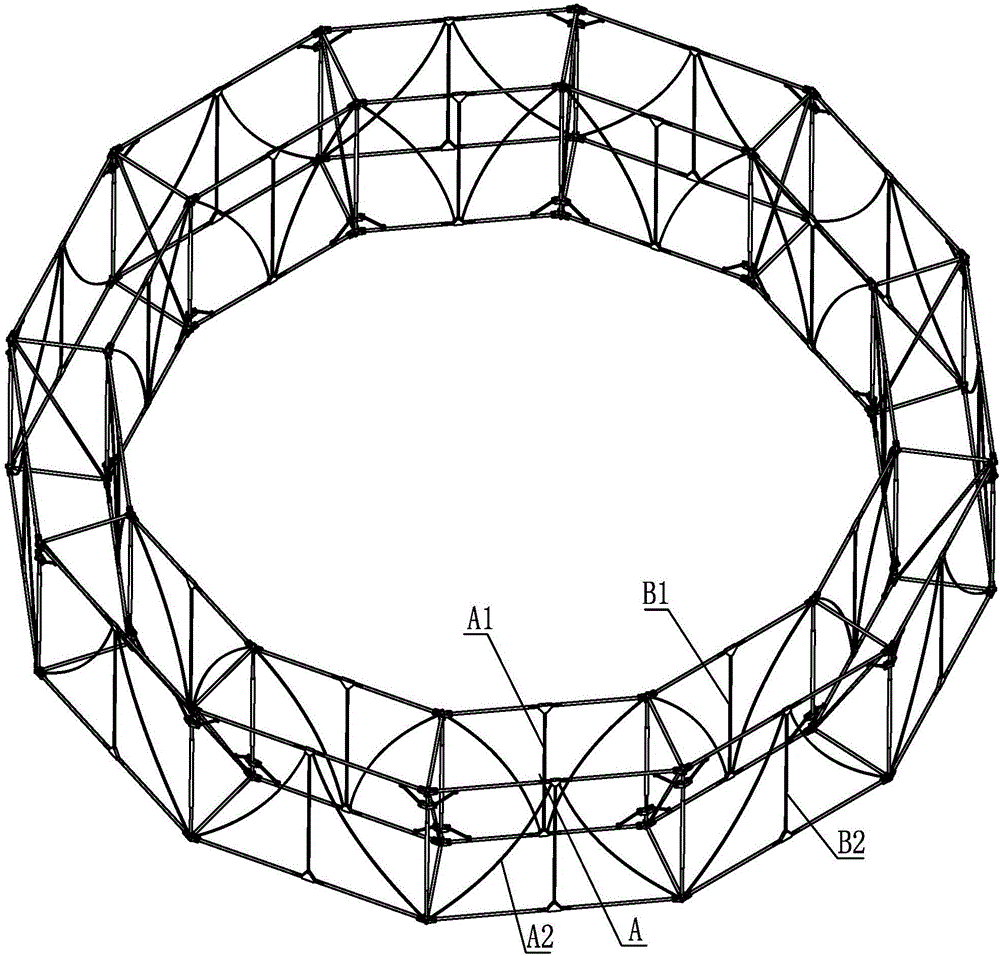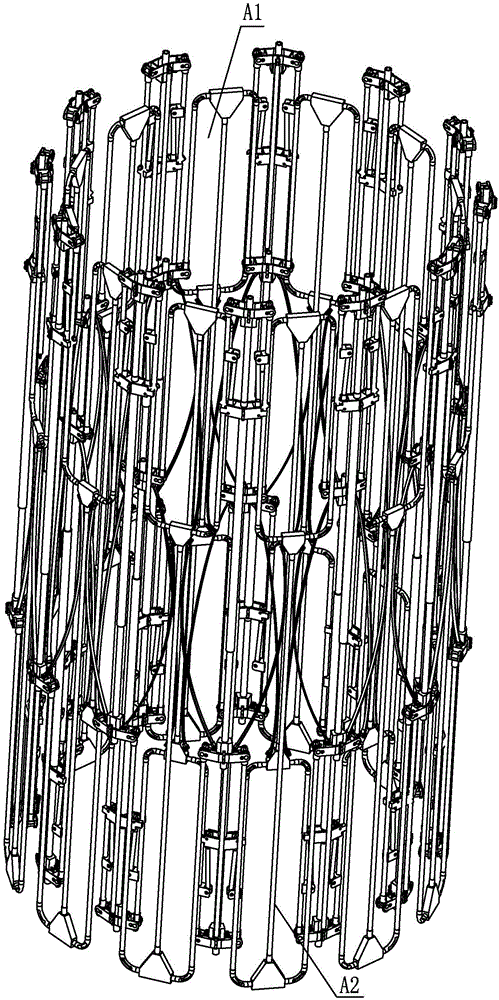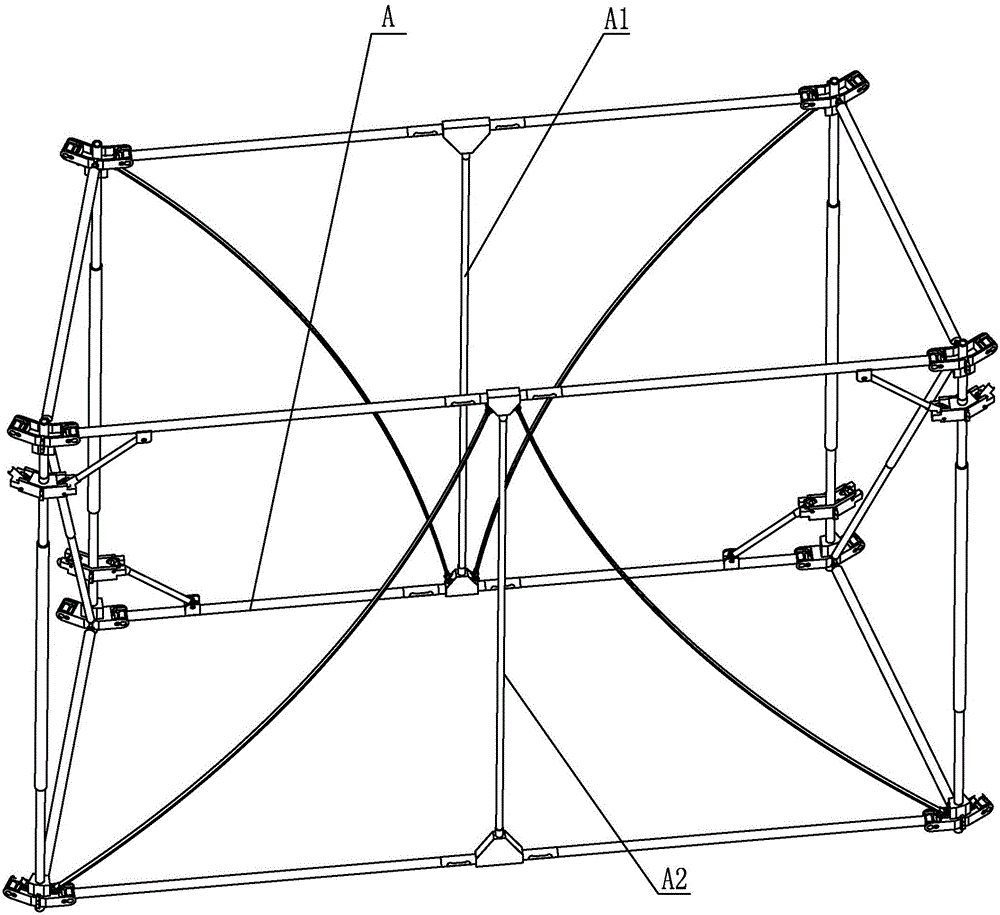Dual-layer ring truss antenna mechanism based on passive drive
A ring truss and antenna technology, which is applied in the field of double-layer ring truss-type deployable antenna mechanism, can solve the problems of easy winding and deployment of cables, failure to meet rigidity requirements, complex drive structure, etc., and achieve light weight and weight reduction , Expand the simple effect of movement
- Summary
- Abstract
- Description
- Claims
- Application Information
AI Technical Summary
Problems solved by technology
Method used
Image
Examples
specific Embodiment approach 1
[0024] Specific implementation mode one: combine Figure 1-Figure 13 Note that the passively driven double-layer ring truss antenna mechanism of this embodiment includes a plurality of inner and outer truss-type foldable unit modules A, a plurality of inner transitional folding components B1 and a plurality of outer transitional folding components B2;
[0025] Each inner and outer truss type foldable unit module A includes an inner foldable unit module A1, an outer foldable unit module A2 and two inner and outer connecting truss assemblies 3;
[0026] The inner folding unit module A1 includes a central connecting vertical rod 5, an upper connecting joint 9, a lower connecting joint 14, two inner upper chords 7, two inner lower chords 16, two inner supporting elastic rods 4, two cranks 10, Two sliders 11, two inner support vertical bars 13, four self-locking hinges 6 and four chords expand and drive elastic hinges 15;
[0027] The upper and lower ends of the two inner support ...
specific Embodiment approach 2
[0034] Specific implementation mode two: combination Figure 4 , Figure 5 , Figure 7 and Figure 8 Explain that the inner transitional folding assembly B1 of this embodiment includes a central connecting vertical rod 5, an upper connecting joint 9, a lower connecting joint 14, two transitional inner supporting elastic rods 51, two transitional inner upper chords 31, two transitional inner The lower chord 32, the two cranks 10 and the four chords expand to drive the elastic hinge 15; between the upper connecting joint 9 and the lower connecting joint 14, a central connecting vertical bar 5 connected with the two is arranged, and two transition inner upper chords 31 coaxial arrangement, the two transition inner lower chords 32 are coaxially arranged, and the two transition inner upper chords 31 are arranged above the two transition inner lower chords 32;
[0035] The two ends of the upper connection joint 9 are respectively connected to a transition inner upper chord 31 thr...
specific Embodiment approach 3
[0039] Specific implementation mode three: combination Figure 4 , Figure 5 and Figure 9 Explain that each of the internal and external connecting truss assemblies 3 in this embodiment includes an upper cross bar 28, a lower cross bar 29, a diagonal upper chord 18, a diagonal lower chord 20, and a chord expansion driving elastic hinge 15;
[0040] Between the diagonal upper chord 18 and the diagonal lower chord 20 is arranged a chord fixedly connected with the two to expand and drive the elastic hinge 15, the upper cross bar 28, the lower cross bar 29, the diagonal upper chord 18, and the diagonal lower chord 20 The elastic hinges 15 driven by the chords are arranged in a Z shape, the diagonal upper chord 18 is hinged with the self-locking hinge 6 on the outer folding unit module A2, and the diagonal lower chord 20 is connected with the self-locking hinge on the inner folding unit module A1 6 are hinged, the upper cross bar 28 and the lower cross bar 29 are hinged between ...
PUM
 Login to View More
Login to View More Abstract
Description
Claims
Application Information
 Login to View More
Login to View More - R&D
- Intellectual Property
- Life Sciences
- Materials
- Tech Scout
- Unparalleled Data Quality
- Higher Quality Content
- 60% Fewer Hallucinations
Browse by: Latest US Patents, China's latest patents, Technical Efficacy Thesaurus, Application Domain, Technology Topic, Popular Technical Reports.
© 2025 PatSnap. All rights reserved.Legal|Privacy policy|Modern Slavery Act Transparency Statement|Sitemap|About US| Contact US: help@patsnap.com



